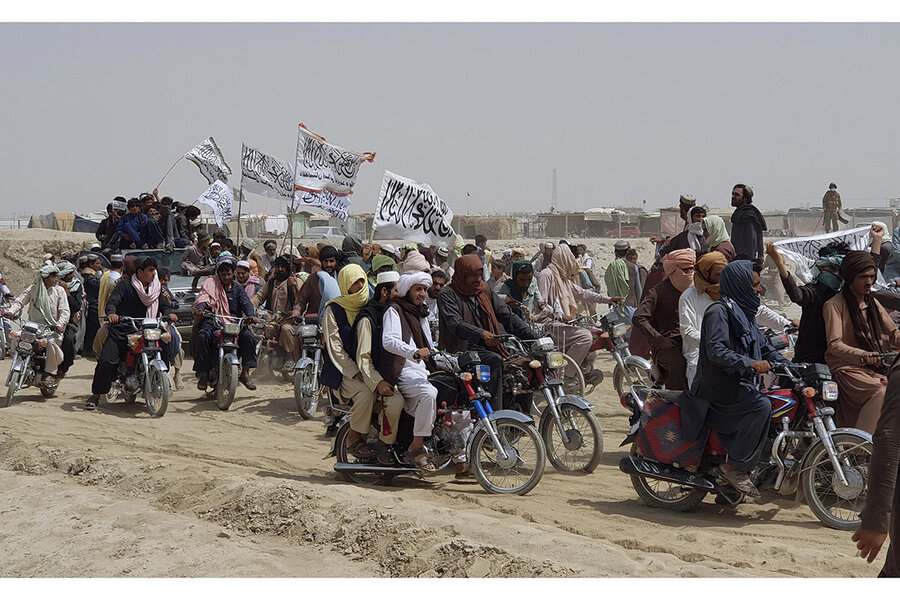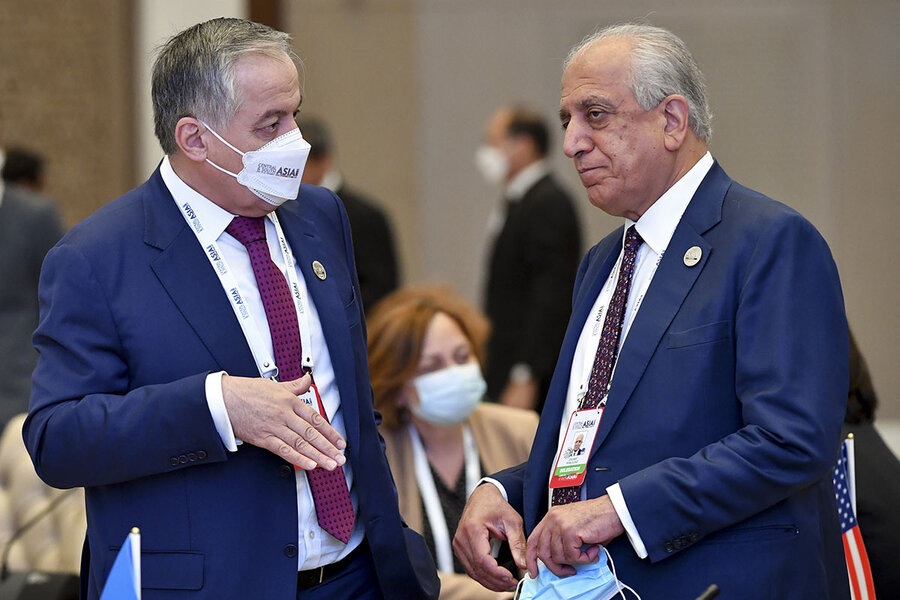
At the time, it was seen as long overdue recognition of an open secret: that Pakistan, a U.S. ally, was backing its enemy, the Taliban.
“We have been paying Pakistan billions … at the same time they are housing the very terrorists that we are fighting,” said Mr. Trump. “But that will have to change.”
WHY WE WROTE THIS
Pakistan’s heavy investment in the Taliban was vital in leading to America’s military defeat in Afghanistan. But is the prospect of a sweeping Taliban victory giving Pakistan second thoughts?
Fast-forward four years, and what has changed instead is that the Taliban are today sweeping across Afghanistan and threatening the U.S.-backed government in Kabul, as U.S. forces withdraw unconditionally.
Pakistan has invested heavily in just such an outcome. Despite consistent denials, Pakistan’s Inter-Services Intelligence (ISI) agency has been instrumental since 2006 in boosting the insurgents with explosives, cash, ideological recruits, and a cross-border safe haven, analysts say.
And yet, as the Taliban juggernaut has accelerated its advance and vowed to re-establish a strict Islamic Emirate, signs of concern are emerging in Pakistan about the dangers of an outright Taliban victory over the United States and the government in Kabul.
Key players in Islamabad may be changing their thinking, as they weigh the prospects of a relatively friendly Taliban-led state against the risk of sparking renewed civil war and instability in Afghanistan, a refugee exodus, and an emboldened cadre of Pakistan’s own recently regenerated jihadists.
“Pakistan wants the Taliban to take power [as] a culmination of the long-term strategy of bringing the Taliban back,” says Asfandyar Mir, an expert in political violence at Stanford University’s Center for International Security and Cooperation.
“But at the same time it is nervous. It certainly appears to have some buyer’s remorse [with] concerns that the Pakistanis are starting to express more and more,” says Mr. Mir, speaking from Islamabad.
Pakistan’s homefront
One Pakistani concern is that the “Taliban’s dependence on them is going down, which has manifested itself in testy, poor behavior in meetings with senior military intelligence officials,” he says, giving Pakistani officials the impression that today’s Taliban are “harder to control” than in the past.
A larger concern for Pakistan is the energizing impact the Taliban’s ascendance is having on Pakistan’s own jihadist insurgents, the Tehreek-e-Taliban Pakistan, or TTP, which has close ties to the Afghan Taliban and has recently regenerated a campaign to overthrow the Pakistani state.

Tariq Achakzai/AP
Pakistani paramilitary soldiers stand guard in Chaman, Pakistan, July 16, 2021, near the Pakistan-Afghan border crossing following fighting between Afghan security forces and Taliban near the Afghan town of Spin Boldak.
Pakistani intelligence and army chiefs reportedly have briefed Pakistani lawmakers that the Taliban and TTP – which has targeted numerous Pakistani intelligence and military officials – are two sides of the same coin.
“Our jihadis will be emboldened. They will say that ‘if America can be beaten, what is the Pakistan army to stand in our way?’” an unnamed senior Pakistani official told The Wall Street Journal of the Taliban advance.
“The TTP has really stepped up its violence against Pakistan. They have been hitting various military targets the last 6 to 12 months,” says Mr. Mir. “Pakistan probably underestimated that if you bring the Taliban to power in Afghanistan, that will obviously embolden Islamist insurgents inside the country. Due to the TTP’s stepped-up attacks, that reality is starting to crystallize.”
The Taliban now control more than half of Afghanistan’s 400-plus district centers – most of those seized since June – but none of the 34 provincial capitals. The United Nations reported Monday that 5,183 civilians were killed or wounded the first six months of this year – a 47% increase over the same period last year.
The United States, Russia, and China have all pressured Pakistan to convince the Taliban not to advance on Kabul, and to instead find a political solution. In March, all four nations issued a joint statement opposing the “restoration of the Islamic Emirate” – the name the Taliban used for their state when they ruled in the late 1990s, which was recognized then only by Pakistan.
The Taliban immediately rejected the statement as “against all principle and not acceptable.”
Khalilzad’s visit to Islamabad
Zalmay Khalilzad, the U.S. envoy for Afghanistan, visited Islamabad July 19 and met with the ISI chief and top officials. Pakistani Prime Minister Imran Khan has said his country, in the past, “made a mistake by choosing between warring parties” in Afghanistan and now has “no favorites.” After meeting Ambassdor Khalilzad, he said instability would cause “serious challenges” for Pakistan.
Just days before, Pakistan had tried and failed to convene a meeting in Islamabad between senior Afghan leaders, including President Ashraf Ghani and former President Hamid Karzai, with top Taliban leaders, to hammer out a power-sharing deal. Pakistan’s national security adviser, Moeed Yusuf, told Indian television Saturday that Pakistan was “obsessively focused” on a political settlement but had “very limited leverage” over the Taliban.
Kabul has complained bitterly for years about Pakistan’s support of the Taliban, and seen few signs of change. Whatever its security concerns, Pakistan has not stopped the Afghan Taliban from using its territory to recruit Pakistani fighters, provide safe haven, or care for wounded fighters.
President Ghani on July 17 said Pakistan had, in the previous month, allowed more than 10,000 “jihadi fighters” to enter Afghanistan.
“Can Taliban convince a single [Afghan] including themselves that they aren’t puppets of Rawalpindi’s GHQ [Pakistani military headquarters]? They are just a kill and destruction squad in the hands of Pakistan,” tweeted Amrullah Saleh, the Afghan first vice president and former spy chief, earlier this month. “Pak has once again opted for a very dangerous and costly adventure,” he said in another tweet.

AP
Tajikistan Foreign Minister Sirojiddin Muhriddin (left) speaks to Zalmay Khalilzad, U.S. special representative for Afghanistan, at the Central and South Asia 2021 conference in Tashkent, Uzbekistan, July 19, 2021. Ambassador Khalilzad, Washington’s point man in talks aimed at ending decades of war in Afghanistan, made a brief visit to Pakistan as relations between Islamabad and Kabul reached a new low.
Peace talks as cover
Afghan officials say Pakistan has also abetted the Taliban’s use of intra-Afghan peace talks, which began last September but made little progress, to prepare for continued war.
Back in January, for example, Taliban negotiators were late in returning to the Gulf state of Qatar for talks scheduled to resume on the 5th.
“Where were the Taliban?” Ahmad Shuja Jamal, head of international affairs and regional cooperation on Afghanistan’s National Security Council, asked rhetorically during a webinar this month hosted by the Frontline Club in London.
The answer, he said, came a few days later, when videos from Pakistan showed Taliban leaders “parading across a line of suicide bombers of the Taliban” and visiting “wounded Taliban terrorists” treated in Pakistani hospitals.
Mr. Jamal accused the Taliban of planting explosive devices manufactured with Pakistani-produced ammonium nitrate “in people’s orchards, in people’s crops, in people’s abandoned homes and pathways into and out of their villages.”
The solution, he said, is for the U.S. and others to “pressure Pakistan, so that they actually do play, finally, a constructive role that only they can play in this equation.”
Pakistan, however, despite stated concern about Afghan Taliban victories, appears to have done little to meaningfully knuckle down.
“There was a big push to mobilize fighters in the last few months, in the [Pakistani] tribal areas and in the Pashtun areas around the south of Afghanistan in Baluchistan,” Carlotta Gall, a New York Times correspondent who covered Afghanistan and Pakistan for more than a decade, said in the webinar.
“We know there are a lot of bodies coming back, including of Pakistanis,” said Ms. Gall, author of “The Wrong Enemy.” The Nangarhar governor’s office tweeted Sunday, for example, that 39 dead Pakistani fighters were sent home the past two weeks. Videos show funerals of fighters in Pakistan, with white Taliban flags held aloft.
“It’s a massive, state-organized campaign, and it’s been going on for 20 years,” said Ms. Gall, whose book title invokes Richard Holbrooke, the late U.S. special representative to Afghanistan and Pakistan, who once said, “We may be fighting the wrong enemy in the wrong country.”
“Pakistan has never given up on its idea to have a client state in Afghanistan,” she said. “It hasn’t changed. It hasn’t stopped. The Americans knew it all along.”
A colonial power
That has been most clear to Afghans, who have been shocked by the speed and scale of destruction of the current Taliban campaign – and are suspicious of any claimed Pakistani change of heart.
“Every Afghan now knows that the name used for these invasions is Taliban, but it’s actually the Pakistani Army in the uniform of the Taliban,” says Orzala Nemat, a Kabul-based analyst.
“Pakistan is planning this, has a huge hand in orchestrating what’s happening. It’s a very sophisticated offensive,” she says. “This time, if the Taliban have a full takeover, the damage ... will spread beyond Afghan borders, to Pakistan, Iran and elsewhere, and everyone should be aware of that.
“We are not faced with some madrasa-educated, ordinary-village young man,” says Ms. Nemat. “We are faced with a colonial power fighting Afghans, again, in the uniform of the Taliban. That is how it should be seen.”
No comments:
Post a Comment